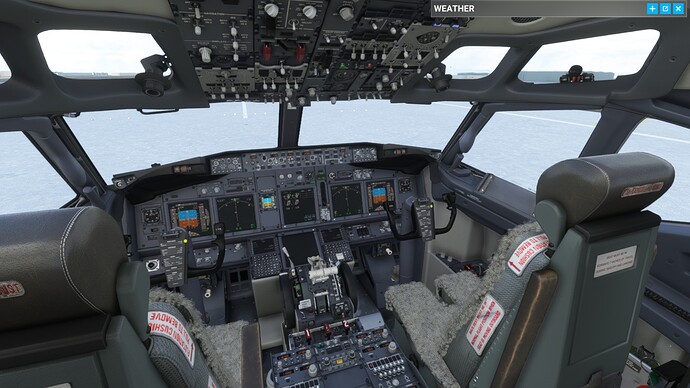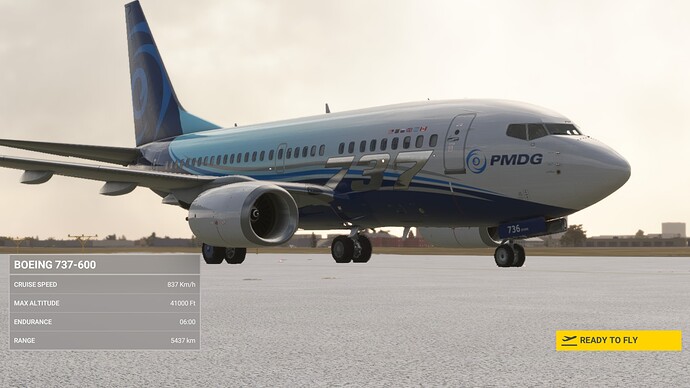Question on VNAV altitude management - When approaching TOD, what new altitude should be set? Do real pilots just dial in something very low (like FL10 or less) and just let the VNAV do it’s thing (obviously being prepared to adjust descent based on ATC requests), or do you “step down” the altitude in smaller blocks. In theory, one could set FL000 at TOD and just let VNAV do it’s thing until glideslope capture. Just wondering how the pros do it.
There wasn’t anything in my post even remotely close to being “negative”. I’m afraid it’s only you who is looking out-of-place in (what had been) a mature, informative and friendly discussion up to the point of your unprovoked meltdown.
I accept your apology and now let’s move on.
Yes, using in game ATC. Overall it’s not bad for what it is tbh. I usually aways ask for FL changes on descent, as ATC ones are usually late as per VNAV path/TOD.
The main thing to me they haven’t fixed yet with in game ATC is the occasional call at 8000ft on approach to climb to FL250(which you ignore) followed by a descend to 3000ft. I have no idea why they haven’t fixed this as it’s been around for ages.
For the most part in game ATC isn’t that bad. I haven’t ventured into the world of vatsim yet.
I think you are doing RW pilots just a slight disservice by saying we would set our V/S mode outside of the aircraft’s performance characteristics (given that this knowledge is a requirement for flying it manually, let alone on autopilot)… ![]()
But I do take your point that VNAV capabilities have improved a lot over the years and are generally less… “abrupt”. I guess some old-school habits just don’t die away. ![]()
It´s kinda strange that the calf of the 737-800, the 737-600, was getting so much hate ![]()
Lovely that little Boeing and how she drank her Kerosene-milk this morning, mooowing of joy when thinking of her first cargo flight…
But there was a strange surprise in the FMC… 145 tons MTOW - I highly doubt that when the biggest freighter the 738 has 79,2 tons MTOW. ![]()
What is this measuring unit used for the 737-600, and how can I set it to tons please? All other 737 have tons and kg in the FMC.
Of all aircraft ONLY the 737 has this epic awesome panoroma view!
Cute hm, and it´s growing so fast! Yesterday it looked even smaller…
I agree, the 736 is lovely.
I believe the weight units are on the 9th page of the Displays Menu. Go to CDU → MENU → SETUP → AIRCRAFT → DISPLAYS . It’s either that, or possibly an attribute of the House Livery.
Pounds, and for the hundredth time, read the documentation provided with the aircraft.
Me too. I pay attention to the AI ATC only on the ground. In the air I mostly ignore it and fly SID/STARs according to the charts. I am just thinking about getting that new Pro-ATC/SR addon as it looks like for Asobo the AI ATC improvement is pretty down on their list to do.
So I’m doing a quick 20 minute flight, using the default fuel and weight settings for the PMDG 737-800. I land at about 130 knots. The moment I land, around 130 knots, I manually deploy the speed brakes, manually brake, and I also manually deploy the reverse thrust to maximum, to slow down as fast as possible.
I noticed the PMDG 737-800 can stop at a very, very, short distance. It goes from 130 knots down to 15 knots, very, very quickly. I’ve flown the FBW A320 and the FBW A320 takes much longer to decelerate to 15 knots. Is this normal with the real life 737-800, that it can slow down that fast?
Edit: Somebody from another forum said this is normal, if I do manual braking. They suggested using auto brake, since that is the proper way to land, and it won’t damage the brakes like manual braking does.
If ATC gives you an instruction to descend, then that’s the altitude you dial in, the one given by ATC. Otherwise, you could do 10,000 since that’s where your speed needs to be 250 or less (240 in the US IIRC). If it’s gonna be an ILS approach, for instance, and there’s no ATC, then dial in the lowest altitude before ILS capture. If you’re putting any altitudes higher than the lowest, you need to pay attention and lower the altitude in time to maintain a continuous descent because if that altitude is captured the AP will level you off, which you don’t want.
Why do you manually deploy the speed brakes? If you arm them during approach they are deployed automatically, so one thing less to worry about.
I agree, and use the in game ATC unless it does something very weird. At the weekend ATC talked me through a decent profile exactly as i was expecting, and it went like clockwork. Obviously it’s not always like that, but mostly it’s not too bad
If you’re using maximum manual braking, you might well be overheating the brakes and at risk of blowing a tire from overheating. To get a feel for how hard you should brake on a dry runway, go into the FMC options for your current livery and enable brake temp monitoring.
It’s been SOP in every airline on every type I’ve ever flown for that very reason. Even then I’ve seen it done, where a V/S was set that either caused the speed to unintentionally increase in the descent or a V/S that was too high for the aircraft to maintain speed at full power.
Remember, SOPs are there for standardisation, and to hopefully stop the lowest common denominator making a mistake on a bad day.
I’ve honestly never heard of this 3-2-1 thing, nor can see any reason to do it! ![]()
@FaultedBirch573 You only ever put a number in that window that you’ve been cleared to by ATC. You would never depart a level unless cleared to do so.
Unless you have toe-brakes on your rudder pedals or have set some other axis for it, manual braking in this sim will always be maximum braking.
Use autobrake 1 or 2 and you’ll see a big difference.
Yep, thanks. I have a button on my joystick mapped to braking. The button will do a full on, 100% brake, which people have mentioned, would damage the brakes or blow a tire in real life. I have to look into how to arm the autobrakes as that appears to be the proper way to brake.
Brakes on any given airplane (at least any I’ve flown) are designed to decelerate the airplane to a stop at go speed (V1). This is going to be the most critical point given weight/speed and the aircraft’s position on the runway. So while you always have max manual braking as an option, you risk a brake fire, flat tires, etc (which is obviously better than an overrun in an emergency). Autobrakes are the norm when decelerating from high speed to prevent these things.
It’s worth noting that “Max” autobraking is different for the a320 and 737. Max on the a320 is essentially “RTO” on the 737 and wouldn’t be selected for landing, whereas the 737 has a Max setting for landing.
You arm the auto brakes in the a320 with one of the buttons labeled “Auto Brk” on the panel above the gear selector. On the 737 it’s a rotary knob labeled “Auto Brake” with the options of 1,2,3 or MAX for landing, and RTO for takeoff.
Generally the ground spoilers are armed during the approach but you do check the handle to ensure extension after touchdown. Easy to do with a control that has a spoiler axis set up.
Sorry mate, no idea why you’re telling me this.


